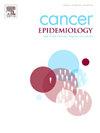A systematic review and meta-analysis of the association of human papilloma virus infections with ocular surface squamous neoplasia
IF 2.4
3区 医学
Q3 ONCOLOGY
引用次数: 0
Abstract
The incidence of Ocular Squamous Surface Neoplasia (OSSN) is increasing, particularly in populations with high HIV prevalence and higher solar irradiance. Human Papilloma Virus (HPV) is considered a precursor/co-factor to OSSN. We aimed to quantify the association between HPV and OSSN and analyse co-factors in this association, including geographical differences and pathology of the comparator group. We used the DerSimonian and Laird method to compute summary odds risk estimates in a random effects model. The I2 statistic was used to quantify heterogenicity. Subgroup analyses, sensitivity analyses and meta-regression were used to explore sources of heterogeneity. Twenty-one studies were included. The odds of HPV was significantly higher in OSSN lesions than benign lesions. The pooled odds ratio was 9.2 (95 % CI: 5.0–16.9) ((I2 = 56.1 % (95 % CI: 26 %-74 %)). In subgroup analysis, the odds ratio was lower in studies from African countries (with high HIV prevalences) and countries closer to the equator. The effect size was lower when ocular surface diseases such as pterygium were used as the comparator group rather than healthy tissues. We report a strong association between HPV and OSSN. The odds of HPV was 9.2 times higher in conjunctival cancers than benign tissues. This association was muted in African countries and countries closer to the equator, highlighting the role of UV radiation and HIV as co-factors in OSSN development. Muting of the association may also signal a role of pterygium as precursor lesions to OSSN, or that HPV may be involved in their development.
人乳头状瘤病毒感染与眼表鳞状瘤变相关性的系统回顾和荟萃分析
眼部鳞状表面肿瘤(OSSN)的发病率正在上升,尤其是在艾滋病毒感染率高和太阳辐照度较高的人群中。人类乳头状瘤病毒(HPV)被认为是导致眼鳞状上皮细胞增生症的前兆/共同因素。我们的目的是量化 HPV 与 OSSN 之间的关联,并分析这种关联的共同因素,包括地域差异和参照组的病理情况。我们采用 DerSimonian 和 Laird 方法,在随机效应模型中计算出总的几率风险估计值。I2 统计量用于量化异质性。亚组分析、敏感性分析和元回归用于探索异质性的来源。共纳入 21 项研究。OSSN病变的HPV几率明显高于良性病变。汇总的几率比为 9.2(95 % CI:5.0-16.9)(I2 = 56.1 %(95 % CI:26 %-74 %))。在亚组分析中,来自非洲国家(艾滋病毒感染率高)和靠近赤道国家的研究的几率较低。以翼状胬肉等眼表疾病而非健康组织为参照组时,效应大小较低。我们报告了 HPV 与 OSSN 之间的密切联系。结膜癌患者感染 HPV 的几率是良性组织的 9.2 倍。在非洲国家和靠近赤道的国家,这种关联性减弱,突出了紫外线辐射和艾滋病病毒在 OSSN 发展中的共同作用。这种关联的减弱也可能表明翼状胬肉是 OSSN 的前驱病变,或者人乳头瘤病毒可能与 OSSN 的发展有关。
本文章由计算机程序翻译,如有差异,请以英文原文为准。
求助全文
约1分钟内获得全文
求助全文
来源期刊

Cancer Epidemiology
医学-肿瘤学
CiteScore
4.50
自引率
3.80%
发文量
200
审稿时长
39 days
期刊介绍:
Cancer Epidemiology is dedicated to increasing understanding about cancer causes, prevention and control. The scope of the journal embraces all aspects of cancer epidemiology including:
• Descriptive epidemiology
• Studies of risk factors for disease initiation, development and prognosis
• Screening and early detection
• Prevention and control
• Methodological issues
The journal publishes original research articles (full length and short reports), systematic reviews and meta-analyses, editorials, commentaries and letters to the editor commenting on previously published research.
 求助内容:
求助内容: 应助结果提醒方式:
应助结果提醒方式:


